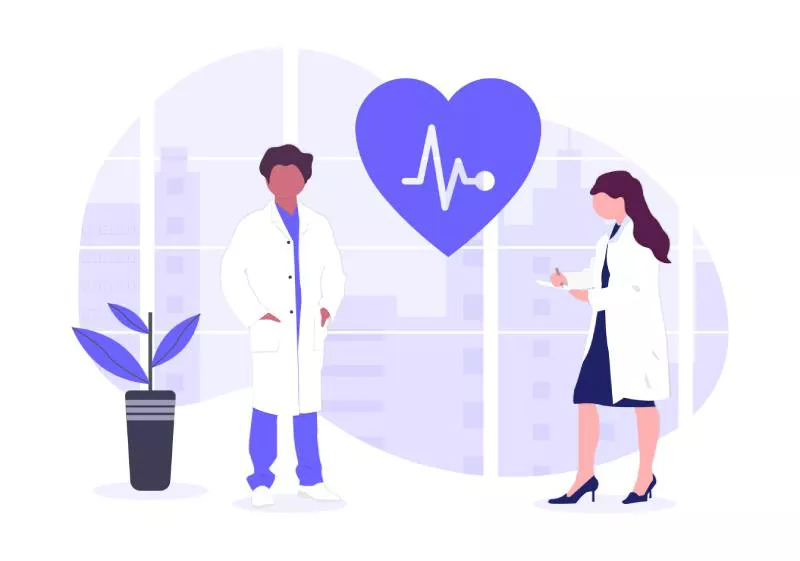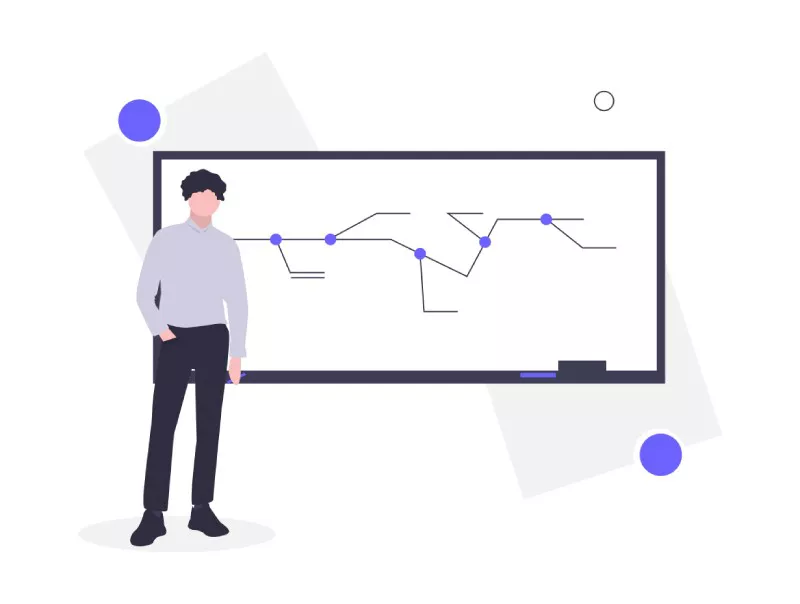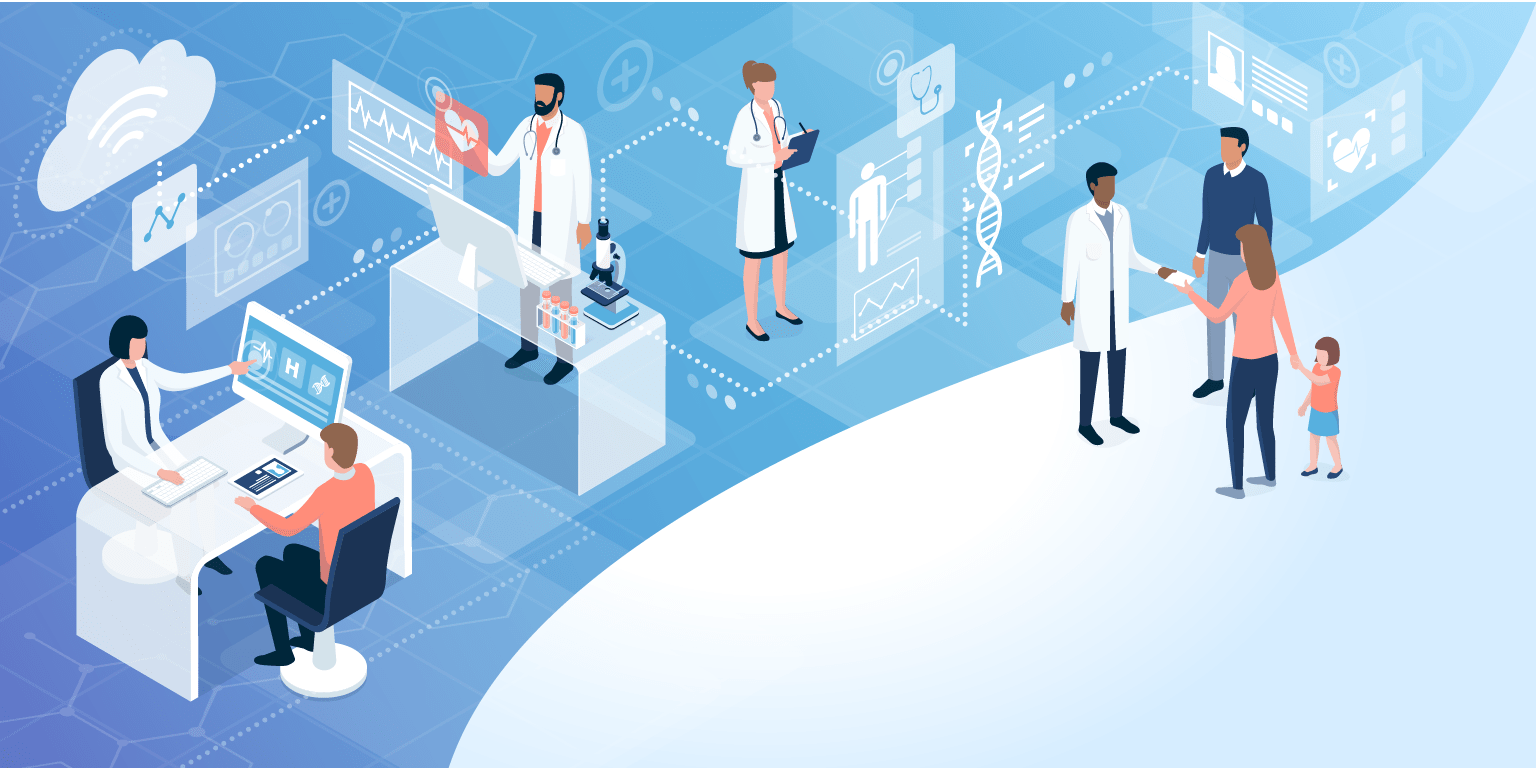We’ve utilized regression models, Monte Carlo simulations, and other methods to anticipate a wide range of scenarios over the years. Healthcare institutions are now using predictive analytics to improve the care of high-need patients.
Predictive technologies can now acquire and analyze data on a massive scale thanks to improvements in information technology. Predictive care algorithms for chronically unwell and frail elders are assisting patients in avoiding hospitalization. And that’s a powerful statement!
The healthcare industry can profit from predictive analytics software in a variety of ways. Population health management, improved reaction time, and financial success are among the benefits.
It’s time to use the power of data and analytics to close the gaps in patient outcomes.
Let’s dive in!
Predictive Analytics in Healthcare: Vital Statistics
Before we start, let’s take look at some quick stats.
- The Global Healthcare Predictive Analytics Market size is set to reach $7.8 billion by 2025 (Source)
- The Society of Actuaries conducted a study in 2017. The study highlighted 93% of health organizations stating predictive analytics was essential to the future of their business. Around 89% of providers were using predictive analytics or were planning to do so in the next five years.
Here’s another quick facet. How much do healthcare organizations spend on unnecessary services and inefficient care?
- According to the National Academy of Medicine, the health care system in the United States spends almost a third of its resources, which is around $750 billion annually (on unnecessary services and inefficient care).
Now, that’s huge!
Predictive analytics tools can make a difference. The technology can improve care and also reduce waste.
Let’s start with understanding some basics.
In the field of medicine, predictive analytics is becoming increasingly popular. Many businesses are investing in big data infrastructure because they believe it will provide a good return on investment (ROI).
Predictive modeling in healthcare is pretty impressive. Hospital administration can benefit from real-time data integration with healthcare systems for chronic disease management and supply chain efficiencies.
Here are some examples of how healthcare organizations have successfully incorporated predictive analytics into clinical practice.
Top Use Cases for Predictive Analytics in Healthcare
Do you believe predictive analytics is limited to real-time alerts? Are there any signals that would assist your healthcare team in taking action?
Because predictive analytics isn’t just about indicators, you’ll need to dig deeper. There’s a lot more to the analytics journey in healthcare than meets the eye.

1. Population Health Management and Risk Scoring for Chronic Illness
Consider this question: what happens when you can predict something?
You guessed correctly! When you can forecast anything, you get a significant advantage in dealing with the situation. The same may be said of healthcare.
Early warnings can help reduce disease progression and enable healthcare providers to respond quickly in the event of outbreaks such as Coronavirus.
Several elements can be used to develop a risk analysis dashboard. It can comprise information from lab tests, biometric data, and patient-generated health information, among other things. The dashboard can deliver more useful information to healthcare practitioners. These findings may aid in the improvement of health-care services.
The Association of American Medical Colleges (AAMC) highlights that the key to improving quality and cost outcomes are reimbursement models that can help with the identification, stratification, and management of high-risk patients.
Predictive modeling can assist you in improving risk management and implementing value-based payments.
2. Restraining Patient Self-Harm and Preventing Suicide
Analytics can help prevent terrible tragedies like suicide. Individuals who are prone to self-harm can be identified early and treated quickly.
For suicide risk detection, electronic health records (EHRs) can also be connected with predictive analytics techniques. The information can be used to correctly identify persons who are at high risk of attempting suicide.
In a study conducted by Kaiser Permanente and the Mental Health Research Network in 2018, the researchers used a combination of EHR data and a standard depression questionnaire. With the help of predictive analytics, the study accurately identified individuals who had an elevated risk of a suicide attempt.
The researchers discovered that among the top 1% of patients identified, suicide attempts and successes were 200 times more likely. Such knowledge can aid in the control of self-harm in patients and, more crucially, the prevention of suicides.
3. Limiting 30-Day Hospital Readmissions
Providers can gain an early idea of the likelihood of readmission during the 30-day window using healthcare predictive analytics software. The alerts could be extremely beneficial to hospitals.
It’s more helpful for hospitals that are subject to significant penalties under Medicare’s Hospital Readmissions Reduction Program (HRRP). The program also has an added incentive for preventing unplanned returns to the inpatient setting.
Tools can provide additional insight on when resources should be focused on follow-up with patients who are at a higher risk of readmission. The data can be used to plan regimens and avoid hospital visits.
Real-time EHR data analytics assisted a Texas hospital cut readmissions by almost five percent. The healthcare professionals achieved this by drawing on nearly 30 data elements included in the patient’s chart.
Ethan Halm, MD, MPH, Professor of Internal Medicine and Clinical Sciences and Chief of the Division of General Internal Medicine at UT Southwestern, reiterated how the study could exhibit the usage of detailed data in EMRs in real-time.
The information can be used to automatically identify and target patients who are at the highest risk of readmission early in their hospital stay. Such information could aid in the improvement and coordination of patient care.
4. Precision Medicine, Genomics, and Personalized Patient Care
Since President Obama’s State of the Union address, precision medicine has become a major player in healthcare.
Genomic research and the development of tailored medicines have been a priority for researchers. Predicting the development of diseases based on a patient’s genetic makeup appears to be a distinct possibility with big data.
Predictive analytics has also proven useful in the fight against cancer. Based on genetic studies, it can aid in the creation of preventative measures for heart disease, diabetes, and even food poisoning.
FDA Commissioner Scott Gottlieb, MD, highlighted how the FDA’s Center for Drug Evaluation and Research (CDER) was using modeling and simulation to predict clinical outcomes.
Clinical trial designs were influenced by modeling by the study team. They also focused on dose optimization, product safety prediction, supporting evidence of efficacy, and investigating probable adverse event mechanisms.
Predictive analytics and clinical decision support systems are crucial in turning novel medications into precision therapeutics in this transformative era of science and medical technology.
With predictive technologies, you can now keep an eye out for better outcomes. Researchers may be able to better grasp the links between genetic polymorphisms and the efficacy of various medications with the help of the program.
5. Analyze and Predict Patient Utilization Patterns
Consider how analytics can help you learn about usage patterns. The data can be useful, and the models can be used to guarantee that personnel levels are ideal. It is possible to cut wait times and improve patient satisfaction by optimizing systems.
You can also expect to use visualization techniques and strategies. When making workflow or schedule changes, the mix can assist in modeling patient flow patterns.
Karen Craver, Clinical Practice Administrator, highlighted how analytics tools helped the oncology infusion center at Wake Forest Baptist Health in North Carolina to anticipate peak utilization times.
They could change their scheduling habits as a result. The utilization rates at the infusion center were studied by the study team. They discovered that popular mid-day appointment periods caused unsustainable surges in demand.
Early morning and late afternoon spots remained unfilled. They changed certain scheduling techniques, resulting in an even distribution. Nurses’ workloads were reduced, and patient satisfaction increased as a result of the modification. Predictive analytics assisted in maintaining appointment rates as well as dealing with strong inclines and drops.
6. Strengthening Data Security
Cyberattacks are becoming more common as technology advances. Predictive analytics can help in this situation.
In terms of cybersecurity, analytics and artificial intelligence can be quite useful. The tools can assist you in identifying patterns in data access, usage, and sharing. As a result, whenever you suspect an intruder has gained access to your network, you’ll be alerted.
David McNeely, a Fellow at the Institute for Critical Infrastructure Technology (ICIT), explained how predictive tools and machine learning techniques could calculate real-time risk scores for specific transactions. He highlights how risk scores can help to grant access for login events. The strategy of challenging multi-factor authentication (MFA) or blocking access for high-risk activities can be useful in preventing ransomware from affecting healthcare organizations.
For healthcare firms, the landscape is fast shifting. It’s now up to you to tailor the benefits of predictive analytics to your own company requirements. If you’re curious about the challenges you might face, here’s a quick rundown. Let’s have a look at some of the current issues.
Biggest Lessons in Predictive Analytics for Healthcare Businesses
So, we now know that predictive analytics may be quite useful in healthcare. But where do you begin, and what are the obstacles and lessons to be aware of when using predictive analytics in healthcare? Let’s see what happens.

1. Involve Frontline Employees throughout the Process
Consider whether you want to construct predictive analytics in-house or hire a technical specialist developer like WDX Technologies to do it for you. The first step is to ensure that the correct individuals are involved at all times.
If frontline staff aren’t convinced or don’t grasp the tools’ usefulness, you’ll find that they are underutilized. As a result, involving those who will utilize these technologies can lead to success. You could try to persuade your clinical personnel to join you by reiterating the benefits and aspects of implementation.
2. Essential Commitment of the C-Suite
As important as it is to engage your frontline personnel, you must also concentrate on the CEOs’ dedication.
You must remember, as organizational leaders, that the vision must always come from the top. As a result, senior management must be dedicated to the predictive tools’ long-term viability.
3. Moral Hazards and Human Intervention
Adopting analytics may present an ethical quandary. There may be certain concerns if a doctor relies more on data than on their own judgment. What exactly is the problem? It entails delegating crucial decisions to a computer and putting the computer in charge of responsibility.
Many specialists emphasize the need of personal contact in rehabilitation. As a result, delegating decision-making to machines would be ineffective. For a sound human judgment, it’s critical to combine acknowledged ethical norms with intervention points.
4. Rapid Changes in Technology
Around the world, technology is rapidly evolving. It is clear that the healthcare industry has been slow to incorporate technology. Healthcare workers, on the other hand, are constantly under pressure to adapt to new trends.
Traditional ways for scheduling appointments are often out of date. The timing is great for investigating advanced technology and specifically customizing it to your healthcare systems.
5. Increasing Privacy Need
The use of electronic health records and speedier data sharing is rapidly increasing. The good news is that predictive analytics can make use of the data.
The problem: the vast amount of data raises serious privacy concerns. Because you have a lot of sensitive personal health information, the concerns are not unfounded. The extensive data sets can aid in the prediction of health patterns and behaviors. However, a proper balance of privacy restrictions is required. Privacy and rigorous rules can help ensure that information is stored, used, and shared safely.
You may have legitimate reservations about the decision-support tools’ implementation. You may always turn to a firm with technological experience, such as WDX Technologies, for assistance with the successful implementation of predictive analytics in your healthcare business.
The Future with Healthcare Predictive Analytics Software
Predictions are a fantastic aspect of analytics. Healthcare experts will benefit from the findings, and the tools will be used in more unique ways in the future.
What should you be on the lookout for in terms of healthcare technology? Using machine learning to enhance healthcare outcomes is a step forward. For high-risk individuals, improved treatment strategies based on similar illnesses will be found. Accenture has already embraced the concept, which involves using search and analytics to improve patient care for healthcare clients.
New datasets will be combined with existing epidemiological sciences and clinical medicine to further our understanding of the links between human biology and external variables. Researchers will also work on improving clinical pathway reengineering in order to deliver tailored care.
Big data and algorithm development in the context of predictive analytics is another topic of interest. Research teams are using new technology to sequence DNA, which could assist to better monitor and manage healthcare data.
With so many new trends to choose from, it’s critical to narrow it down to what matters most to you and what you can do about it. Predictive analytics offers a fantastic potential to cut costs while also improving patient care. It is up to you to achieve the finest outcomes.
Healthcare Organizations That Are Using Predictive Analytics
1. UChicago Medicine
The University of Chicago Medical Center uses predictive analytics to efficiently address issues like operating room delays. UChicago Medicine was able to issue warnings, optimize workflows, and streamline handoffs across different teams thanks to a mix of real-time data and a powerful event processing algorithm.
Predictive analytics assisted UCMC in reducing turnover time by 15 to 20%, saving an estimated $600,000 per year.
2. Cleveland Clinic
Cleveland Clinic, the world’s leader in healthcare research and teaching, was under great financial strain due to fixed reimbursements. They sought to shorten patients’ stays, so they gathered information on discharge delays.
The researchers used predictive analytics to determine which patients have a good probability of healing at home and which require inpatient rehabilitation. Cleveland Clinic was able to save expenses, shorten stay times, and improve patient satisfaction as a result of the endeavor.
3. Kaiser Permanente
To limit the usage of antibiotics in neonates, Kaiser Permanente created a risk calculator. The goal was to limit antibiotic exposure in neonates and only treat those who were at the greatest risk of illness.
Based on the data of 600,000 babies and their moms, the development team created a prediction model. KP was able to safely reduce his antibiotic use by 50% thanks to the prediction model.
4. Penn Medicine
To improve prognosis, this Philadelphia-based healthcare system uses predictive analytics. The prognosis score is calculated using data from patients’ electronic health records (EHRs) and machine learning algorithms.
The score is calculated using over 30 different factors. It aids clinicians in determining a patient’s prognosis for the next six months.
5. CheXNeXt by Stanford University
Stanford University researchers are working on an AI program dubbed CheXNext to filter chest X-rays. In a matter of seconds, the program can test X-rays and detect roughly 14 distinct diseases.
The researchers intend to use this tool to assist emergency patients and expedite urgent care diagnoses.
Develop Healthcare Predictive Analytics Tools with WDX Technologies
Do you want to know how to use analytics technologies to improve patient care in your healthcare organization? Please contact us.
We are a multi-award-winning technology firm with extensive expertise in designing custom AI software for enterprises ranging from startups to Fortune 500 companies. Many corporations and individual entrepreneurs have benefited from our sophisticated healthcare online solutions.
Got A New Project?
Book a meeting with one of our team members or get a ball park estimation on your project.
Book A MeetingGet A Rough EstimateFrequently Asked Questions
1. What is predictive analytics in healthcare?
In healthcare, predictive analytics refers to the storing and analysis of data in order to forecast outcomes and make informed decisions.
2. What are some examples of using predictive analytics in healthcare?
Top Use Cases for Predictive Analytics in Healthcare:
- Population Health Management and Risk Scoring for Chronic Illness
- Restraining Patient Self-Harm and Preventing Suicide
- Limiting 30-Day Hospital Readmissions
- Precision Medicine, Genomics, and Personalized Patient Care
- Analyze and Predict Patient Utilization Patterns
- Strengthening Data Security
3. What you should know before implementing predictive analytics in healthcare?
- Involve Frontline Employees throughout the Process
- Essential Commitment of the C-Suite Management
- Moral Hazards and Human Intervention
- Rapid Changes in Technology
- Increasing Privacy Need
4. Which organizations use healthcare predictive analytics tools?
Some top healthcare organizations that use predictive analytics to improve patient care include:
- UChicago Medicine
- Cleveland Clinic
- Kaiser Permanente
- Penn Medicine
- CheXNeXt by Stanford University
Related Articles
Translating innovation to sustainable business growth.
Let’s Work Together to Create the Future We Want
WDX Technologies helps businesses turn their ideas into successful digital realities. We excel in creating digital solutions that solve critical pain points while making you and your customers the HERO.


